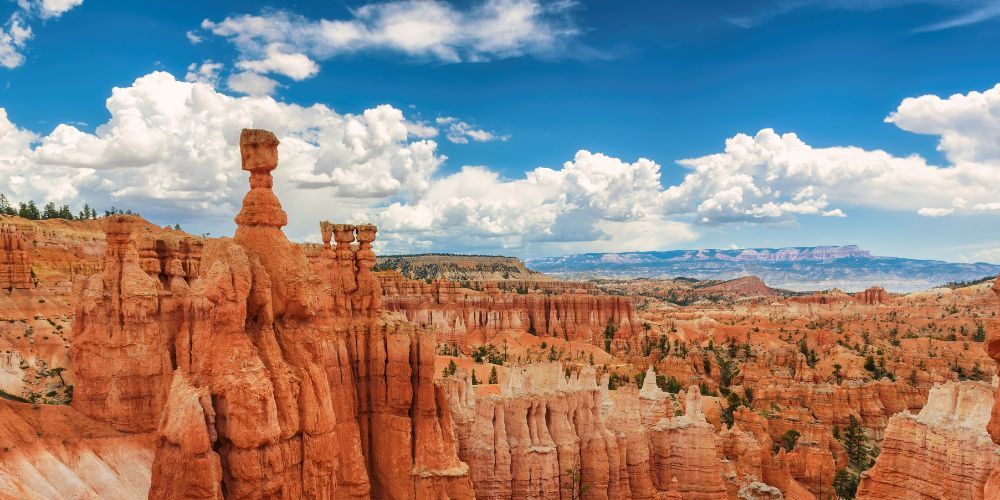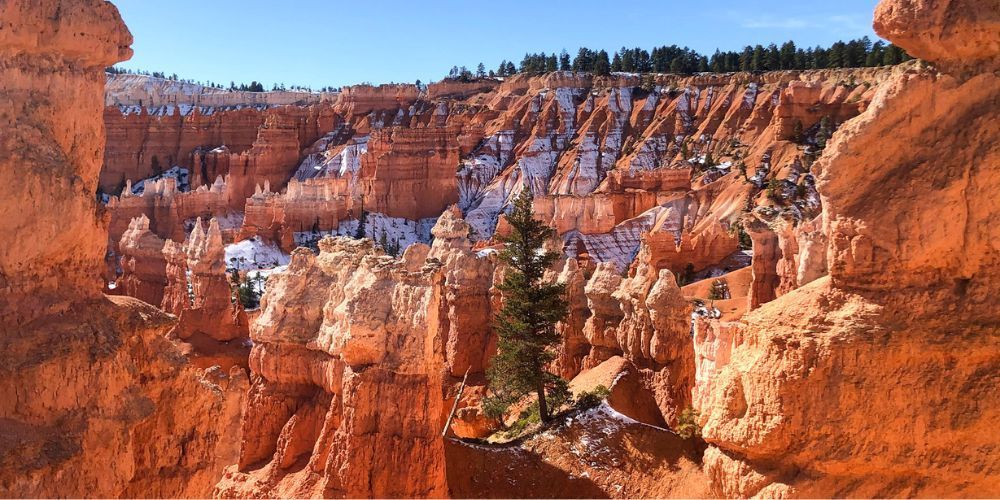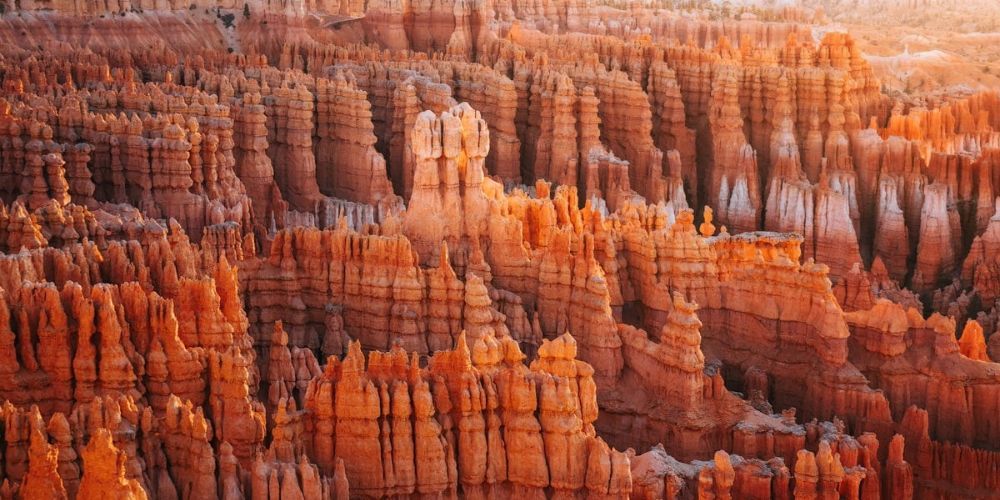Explore the Beauty of Bryce Canyon National Park in Utah: Hiking Trails, Scenic Views, and More
August 23, 2024
Bryce Canyon National Park isn't just another stop on your travel list; it’s a place where towering hoodoos meet clear, star-studded skies. This park in southwestern Utah spans over 35,000 acres and offers landscapes so otherworldly they feel like scenes from a dream. The unusual rock formations, known as hoodoos, draw over 2.5 million visitors each year, creating an unforgettable backdrop well worth the journey.
Beyond its unique geology, Bryce Canyon boasts some of the clearest night skies you’ll ever see, perfect for stargazing. This guide brings together extensive research and practical insights to help you make the most of your visit—from securing accommodations early to navigating the best hiking trails and viewpoints. Whether you're an avid nature photographer or simply looking to explore, you'll find everything you need to plan an incredible trip.
The top hiking trails in Bryce Canyon National Park include the Queens Garden Trail, Navajo Loop Trail, and Peekaboo Loop Trail. These trails offer stunning views of the park's iconic hoodoos and provide a memorable hiking experience for visitors.

Overview of Bryce Canyon National Park
Bryce Canyon National Park, nestled in the stunning landscapes of southwestern Utah, is a land of intricate geological wonders and natural beauty. Spanning approximately 35,835 acres, this park isn't just a scenic gem; it's like stepping into another world entirely. Imagine towering spire-shaped rock formations known as hoodoos rising dramatically from the earth, sculpted over millions of years by the forces of erosion and weathering. The result is a mesmerizing array of colors and shapes that define the park's surreal and otherworldly landscapes.
These hoodoos, formed through the gradual processes of sedimentary rock erosion and frost-wedging, are truly a sight to behold. Each hoodoo seems like a work of art created by nature itself, standing as silent sentinels throughout the park. It's no wonder that visitors from around the globe flock to witness this geological masterpiece.
Picture yourself standing amidst these towering structures, feeling humbled by the sheer magnitude of nature's craftsmanship. The park’s renowned viewpoints such as Sunrise Point, Sunset Point, and Inspiration Point offer breathtaking vistas, showcasing the ethereal beauty created by these geological formations.
Established in 1928, Bryce Canyon National Park has remained a beloved destination for nature enthusiasts and adventurers alike. Its remarkable landscapes continually attract over 2.5 million visitors annually, solidifying its status as a must-see natural wonder in the United States.
Bryce Canyon is not only about its mesmerizing geological formations; it's also part of the larger Colorado Plateau, renowned for offering some of the clearest night skies in North America. This sets the stage for unforgettable stargazing experiences, allowing visitors to gaze upon the twinkling canvas above with clarity rarely found in other locations.
“Inspired by Neil deGrasse Tyson’s exploration of our universe.”
So, whether you are drawn in by its enchanting hoodoos or enticed by the allure of stargazing under pristine night skies, Bryce Canyon National Park has something exceptional to offer every visitor.
As you plan your enriching visit to Bryce Canyon National Park, uncover invaluable tips that will make your experience even more rewarding.
Tips for Planning Your Visit
Planning a trip to Bryce Canyon National Park can be just as exciting as the actual visit. Here are some important tips to ensure a smooth and enjoyable experience during your adventure.
Booking Accommodations
Accommodations within or near the park range from camping options to nearby hotels in Bryce Canyon City. If you prefer the convenience of staying within the park, reservations should be made well in advance, especially during peak seasons such as summer. For those who seek a rustic experience, the campgrounds within the park offer a more immersive way to connect with nature. On the other hand, if you prefer the comfort and facilities of a hotel, Bryce Canyon City provides several options for accommodation. It's crucial to consider factors such as proximity to park entrances, availability of amenities, and personal preferences when choosing the right place to stay.
It's recommended to book accommodations as early as possible, as popular sites tend to get fully booked well ahead of time during peak seasons.
Entrance Fees and Passes
Before you set out on your journey, it's important to consider the entrance fees and passes needed for accessing the park. The current entrance fee for Bryce Canyon National Park is $35 per vehicle. However, if you plan to explore multiple national parks throughout the year, purchasing the America the Beautiful Pass for $80 could provide substantial savings. This annual pass grants access to more than 2,000 federal recreation sites across the United States.
The America the Beautiful Pass not only offers value for those planning visits to various national parks but also contributes directly towards supporting outdoor recreation opportunities and conserving natural beauty for future generations.
Transportation and Parking
Upon arrival at Bryce Canyon National Park, parking can be limited due to high visitor numbers, particularly during peak seasons. To secure parking close to your desired trailhead or scenic viewpoint, it's advisable to arrive early in the day. If parking lots are full, rangers might restrict entry until spaces become available again.
During the busy months of April through October, visitors can take advantage of the park's shuttle service designed to alleviate parking issues and reduce congestion. The shuttle operates along the main road in the park and stops at key points of interest, allowing visitors to comfortably explore different areas without worrying about parking availability or traffic.
By considering these factors and making necessary arrangements in advance, your visit to Bryce Canyon National Park is more likely to be stress-free and filled with unforgettable experiences amidst stunning natural landscapes.
Just as planning sets the stage for an incredible experience at Bryce Canyon National Park, understanding its unique features and attractions amplifies the excitement of exploration. Let's now turn our attention to uncovering the distinctive spots that make this national treasure truly special.
Key Attractions and Unique Spots
As you step into Bryce Amphitheater, you'll encounter a breathtaking sight that is hard to forget. This natural amphitheater is the star of Bryce Canyon National Park, boasting some of the most striking and iconic hoodoos—tall, thin spires of rock—that create a mesmerizing landscape.
Bryce Amphitheater
Sunrise Point, Sunset Point, and Inspiration Point are the prime locations for taking in the awe-inspiring views of the amphitheater. The way the sunlight plays upon these natural formations throughout the day creates a constantly changing canvas of colors, making each viewpoint a distinct experience. The dramatic silhouettes and vibrant hues will leave you captivated, especially during sunrise and sunset.
Thor's Hammer
A standout feature within the Navajo Loop Trail, Thor's Hammer is a unique and recognizable hoodoo that looks remarkably like its namesake. This distinct formation is one of the most photographed features in Bryce Canyon National Park.
The trail leading to Thor's Hammer offers an up-close experience with these mystical structures, allowing visitors to feel dwarfed by the towering hoodoos and truly appreciate their scale and intricacy.
Mossy Cave
Visiting Mossy Cave provides a different glimpse of natural beauty within the park. Nestled on the park's northern edge, this spot showcases a stark contrast to the typical scenery of hoodoos. Here, you'll find a natural spring-fed cave and a tranquil waterfall, surrounded by verdant moss and lush plant life.
This serene location offers a refreshing change from the vast hoodoo-filled areas, providing an intimate connection with nature as you follow the trail leading to this hidden gem.
These remarkable attractions at Bryce Canyon National Park offer unique experiences and showcase the diverse natural wonders waiting to be explored. Each spot contributes to the park's rich tapestry of landscapes and geological formations, ensuring that every visitor has an unforgettable adventure.
Popular Hiking Trails
Bryce Canyon National Park is renowned for its enchanting hiking trails that wind through the awe-inspiring natural amphitheaters and iconic formations. One of the most beloved trails is the Navajo Loop Trail, spanning 1.3 miles and boasting a moderate difficulty level, making it accessible to many hikers. This trail takes you through the heart of Bryce Amphitheater, treating you to breathtaking views of iconic formations like Thor's Hammer and Wall Street.
What makes the Navajo Loop Trail even more enticing is the variety it offers. From towering hoodoos to narrow switchbacks, this trail provides a truly immersive experience into the otherworldly landscape of Bryce Canyon.
Queen's Garden Trail
Another must-explore trail is the Queen's Garden Trail, featuring a 1.8-mile path that offers hikers an opportunity to descend into the canyon while reveling in captivating scenery along the way. The trail is considered one of the least difficult routes into the canyon, making it suitable for hikers of varying skill levels.
This trail showcases the delicate beauty of Bryce Canyon as it winds through archways and towering rock formations, offering a mesmerizing experience that immerses hikers in its unparalleled natural splendor.
Rim Trail
For those seeking an unforgettable stroll with unparalleled panoramic views, the Rim Trail is a 5.5-mile stretch that offers just that. This mostly flat trail runs between Bryce Point and Fairyland Point, providing uninterrupted views of hoodoos, fins, and windows.
The Rim Trail unveils an ever-changing tapestry of stone spires and rugged landscapes, making it an ideal option for visitors who want to explore the park’s stunning features without delving too deeply into its contours.
Each of these trails offers a unique perspective on Bryce Canyon National Park, providing hikers with an opportunity to witness its remarkable geological wonders up close.

Scenic Viewpoints and Photography
As the sun rises over Bryce Canyon National Park, a gentle wash of light starts to reveal the intricate details of the famous hoodoos. Sunrise Point is the place to be at this magical time. The interplay of light and shadow creates a mesmerizing beauty that changes by the minute as the sun makes its ascent. It's a perfect spot for photographers looking to capture the stunning play of colors during sunrise. As you stand here, you can see nature's paintbrush at work as it brings out the vivid hues and textures in the rock formations.
Moving along, Bryce Point offers a different vantage point, giving photographers a chance to capture expansive panoramic views any time of day. From this elevated viewpoint, visitors can admire the stunning natural amphitheater carved into the landscape by millions of years of erosion. As sunlight shifts throughout the day, it paints rich shades of red, orange, and pink onto the hoodoos, creating an ever-changing canvas for photographers to capture. This viewpoint is particularly enchanting during sunrise and sunset, as the shifting light transforms the landscape into something truly otherworldly.
At 9,105 feet above sea level, Rainbow Point is known for its panoramic views that stretch out for miles in all directions. From here, visitors can take in a breathtaking vista that includes not only the awe-inspiring Bryce Amphitheater but also the distant Kaibab Plateau and other rugged formations that punctuate the park's horizon. This vantage point provides a spectacular opportunity for wide-angle photography, capturing the grandeur and scale of this unique natural wonder. Photographers can experiment with composition to feature layers of colorful rock formations that seem to go on forever.
These viewpoints aren't just great for snapshots - they offer an opportunity to witness nature's artistic prowess firsthand, capturing its ever-changing beauty in a timeless image.
Capturing these exquisite moments through the lens provides an unparalleled insight into Bryce Canyon's allure. Let's now dive into understanding its weather patterns and finding the optimal times to embark on this captivating adventure.

Weather and Best Times to Visit
Understanding the seasonal fluctuations and their impact on your experience at Bryce Canyon is crucial.
Summer brings temperatures ranging from 40°F to 80°F, making it the most sought-after season due to its warm weather. However, the popularity of this season means bigger crowds, leading to longer queue times at the viewpoints and trails. On the other hand, winter paints a breathtaking picture with temperatures dropping below freezing and an annual snowfall of about 95 inches. While this creates a picturesque landscape, it does present challenges for visitors in terms of accessibility and navigating through extensive snow.
It’s important to consider not just the temperature but also how it affects the overall park experience. The summer heat coupled with large crowds can lead to discomfort while winter might limit certain areas' access. You may also encounter trail closures or route restrictions during winter months.
For those seeking a more serene adventure with milder weather and fewer crowds, spring and fall are considered optimal visiting times. September and October are especially favored for their mild temperatures as the foliage begins its mesmerizing transformation, creating ideal conditions for hiking and capturing stunning photographs of vibrant landscapes.
These seasons offer a balance—providing comfortable weather without extreme temperature fluctuations and presenting opportunities for more intimate experiences with nature and the park's attractions.
Understanding the weather patterns and considering the best times to visit Bryce Canyon National Park is vital in order to make the most of your trip, ensuring a memorable experience and avoiding potential limitations due to seasonal variations.
Wildlife and Nature Encounters
One of the most thrilling aspects of visiting Bryce Canyon National Park is the potential for up-close encounters with its fascinating wildlife. Whether you're an avid birdwatcher or simply appreciate observing nature's wonders, the park offers a rich tapestry of animal and plant life waiting to be discovered.
Common Wildlife
The canyons and forests of Bryce Canyon National Park are home to a variety of wildlife. Visitors may have the chance to spot the graceful mule deer, swift pronghorns, and if lucky, even catch sight of the elusive mountain lion. For bird enthusiasts, the park is a paradise with over 200 avian species soaring through its skies, including the magnificent California condor. These encounters with nature's creatures serve as captivating reminders of the intricate ecosystems thriving within the park's boundaries.
It's essential for visitors to remember that these animals call this place home, and we are merely guests in their domain. As such, respecting their space and maintaining a safe distance is paramount for both their well-being and our own safety.
Flora and Fauna
Elevation variations within the park support a diverse range of plant life, creating an awe-inspiring demonstration of nature's resilience. From the stately ponderosa pines at higher elevations to the hardy pinyon pines and junipers further down, each ecosystem fosters its own unique blend of flora and fauna.
Each turn along the hiking trail can reveal a new combination of plants and trees at different elevations. The striking contrast between the tall, straight trunks of ponderosa pines against the rugged terrain creates an enchanting visual tapestry that showcases the park's botanical diversity.
Safety Tips
To ensure a safe and enjoyable wildlife experience, it's essential to follow specific guidelines while exploring Bryce Canyon National Park. Always stick to designated trails to avoid disrupting natural habitats and endangering wildlife. It's crucial to maintain a respectful distance from animals and refrain from feeding them. Another vital tip is carrying a map and staying hydrated during hikes, as the high elevation can lead to dehydration more quickly than expected.
Remember, sticking to these simple rules not only protects wildlife but also enhances your own experience at this natural wonder.
Embracing wildlife encounters at Bryce Canyon National Park provides an extraordinary opportunity to witness nature's wonders firsthand while contributing to the conservation efforts that safeguard these precious environments for generations to come.
A journey through Bryce Canyon National Park promises not just an adventure into nature's beauty, but also a chance to connect with its inhabitants and contribute to their preservation.
What are the best hiking trails in Bryce Canyon National Park?
Bryce Canyon National Park offers a variety of stunning hiking trails suitable for all skill levels. Some of the most popular trails include:
Navajo Loop Trail: This 1.3-mile loop is one of the most famous in the park. It takes you through the iconic Wall Street section, where towering hoodoos create a surreal landscape. The trail is moderate in difficulty and offers some of the best views of Bryce’s unique rock formations.
Queen’s Garden Trail: A relatively easy 1.8-mile round-trip trail that connects with the Navajo Loop, allowing hikers to explore the canyon floor and get up close to the hoodoos. The trail is especially popular for its scenic beauty and accessibility.
Fairyland Loop Trail: For those seeking a longer hike, the Fairyland Loop is an 8-mile trek that offers more solitude and spectacular vistas. It is considered strenuous due to its length and elevation changes but rewards hikers with less-crowded trails and breathtaking views of the canyon’s diverse landscapes.
Each of these trails provides a unique perspective of the park’s natural beauty, and visitors are encouraged to choose based on their fitness level and the amount of time they have to explore.
What are the best times to visit Bryce Canyon National Park for optimal weather and views?
The best times to visit Bryce Canyon National Park are during the spring (April to June) and fall (September to October) months. During these periods, the weather is mild, and the crowds are smaller compared to the summer peak season. Spring brings wildflowers and clear skies, making it ideal for photography and hiking. Fall offers cooler temperatures and vibrant autumn colors that enhance the park’s already stunning landscapes.
Summer (July to August) is the busiest time at Bryce Canyon. While the weather is warm and sunny, it can also be crowded, and afternoon thunderstorms are common. Visitors during this time should plan to arrive early or later in the afternoon to avoid crowds and enjoy cooler temperatures.
Winter (November to March) provides a unique experience as the park’s red rock formations are often dusted with snow, creating a beautiful contrast. However, some trails may be icy or closed due to snow, so visitors should check the conditions in advance and be prepared for colder temperatures.
Are there guided tours available at Bryce Canyon National Park?
Yes, Bryce Canyon National Park offers a variety of guided tours that cater to different interests and activity levels. These tours provide visitors with an in-depth understanding of the park’s geology, history, and wildlife, often led by knowledgeable park rangers or certified guides. Some popular guided tour options include:
Ranger-Led Programs: Throughout the year, the park offers ranger-led programs such as guided hikes, astronomy programs, and evening campfire talks. These programs are typically free and offer a great way to learn more about the park’s natural and cultural history.
Horseback Riding Tours: For a unique perspective, visitors can explore the park on horseback. These tours are operated by concessionaires and provide an opportunity to see the park’s landscapes from a different vantage point.
Shuttle Tours: During the peak season, shuttle tours are available, offering an easy way to explore the park’s main viewpoints and attractions without the hassle of parking. These tours often include interpretive talks and stops at key sites.
Booking a guided tour in advance is recommended, especially during the busy summer months, to ensure availability and enhance your visit with expert insights.
Check out the latest guides on hiking gear
Author: William Flaiz










